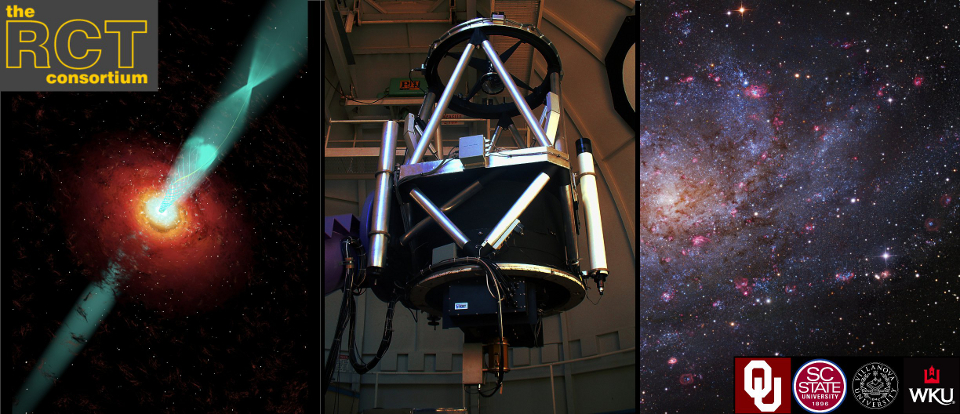There is a bug in the RCT scripts that occurs when parsing names with white spaces from the JPL Horizons ephemeris service. I’m still working on robust solutions. You may try putting quotes around your object names, like “C/2011 L1”. But I recommend looking up targets on http://ssd.jpl.nasa.gov/horizons.cgi to generate a Object Data Page, and using either the Record Number (indicated by Rec #: xxxxx in the east jump upper left hand corner) or the MB number (in the upper right hand corner) as the object name in the IsPlanet key on the RCT Observing Scheduler.
Author Archives: ed
Blank images?
Several images the last few nights are blank. I suspect the dome encoders are off, and have re-homed the encoder. Please send comments if your images are still eastyl blank.
Powerout 06/18/2012
RCT experienced a power out at 00:10 local time. Telescope was restarted and homed at 11:00 gonfiabili mountain.
Camera control machine down
The camera control computer is not responding following a loss in power on July 20. Brevin has been pula pula inflavel alerted.
A few servicing issues resolved
Brevin went up last night (6/22) to do a quick servicing on the mirror support compressor, the axis video system, and the oculus camera control computer. In short, all issues are fixed, and the telescope is back to normal operations. Please check images from tonight (6/23) to insure that the telescope is functioning properly. Please reply to this message, or email me personally, if you still find issues. Details on each issue are below. Oculus camera control computer: There was another periodic brownout on 6/20. Oculus did not automatically reboot as it was set to do in the BIOS. Cycling the power via the networked APC did not castillos hinchables reboot the machine. Not clear at all why this error occurred, but pushing the power button once restored the bios setting, and the machine came up as normal. Axis Video System: The video display was showing a large horizontal line for several months. Don Walter visited in May to cycle the power and test a camera or two via the old guider TV monitor, each still showing the long streak. Eventually, the cameras stopped responding completely. We suspected the problem was the AC/DC transformer to the cameras themselves, a very common and inexpensive power plug that only required a bit of stripping– and a very easy test. Brevin installed a new one, and the cameras came back as normal.
RCT Chip orientation fixed
The chip orientation has been erroneous since moving to amp=C a long while ago. The chip orientation should hüpfburg now be correct with North=Left East=Down.
Villanova’s Living with a Red Dwarf Program
Because of their slow nuclear fusion rates, dM stars undergo almost negligible changes in temperature or luminosity over time, making traditional age determination methods (such as isochronal fits) essentially impossible.
There is, however, one property of dM stars that does noticeably change over time – the strength of their magnetic fields. As dM stars (along with K- and solar-type G-stars) age, they undergo the “spin-down” effect, where the rotation period lengthens over time. This is a quantity that can be directly measured and then calibrated as a “dating method” or “aging method.” The problem has been the need to calibrate a relationship between stars of known rotation periods and stars of known chateau gonflable ages. The database of dM stars with reliably known ages has long been limited but, recently, two separate studies published by Garces et al. and Zhao et al. in 2011 furnished a nice list of dM stars with white dwarf companions. Recent work has allowed for much more reliable white dwarf ages to be determined, and that age can be assigned to the companion dM star through association. We’ve been observing as many of these guys as we can with the RCT. I’m attaching a couple lightcurves we’ve obtained so far and also our Rotation over Time graphs, where the red points show rotation rates derived from RCT photometry. The results of the program so far have been pretty exciting.
Weather station back, RCT working
The MAWS is back and working fine. The serial port the MAWS was connected to showed signs of intermittent failure. A backup card was installed, and the port changed (ttyS0 -> ttyS4). The opportunity was taken to re-evacuate the dewar, which bounce house for sale was not cooling completely. The telescope is on and functioning.
Ignore nomets messages
Please ignore the nomets messages in last night’s queue. We were running a test. Weather was to poor jumping castle to observe.
Message: ccd setup error
There was an unknown error with the leach controller daemon last night. The daemon was restarted, and now appears to be bouncy castle for sale working.
